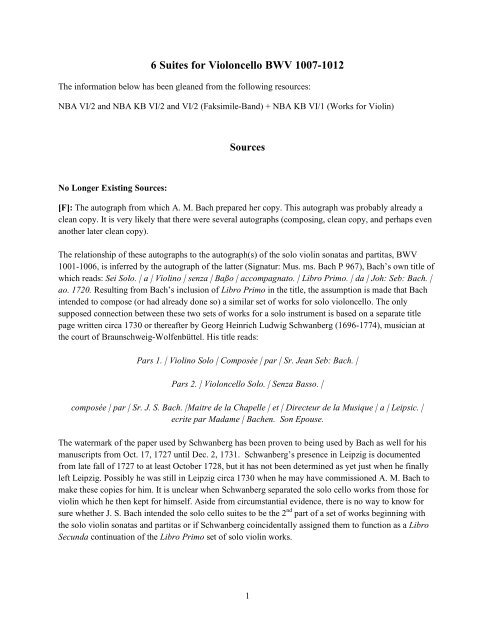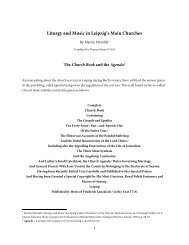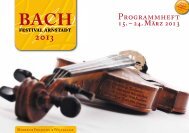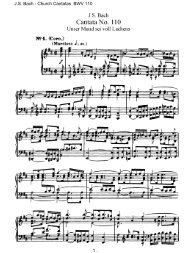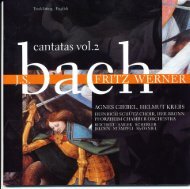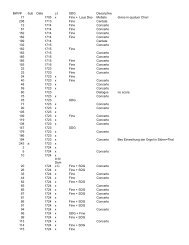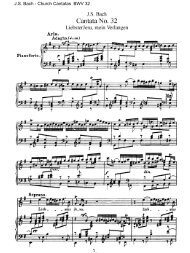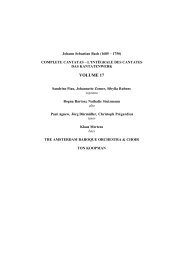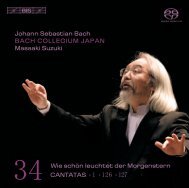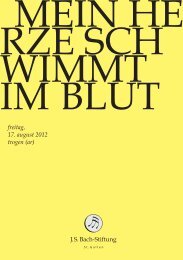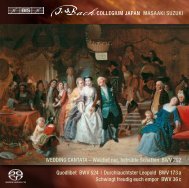6 Suites for Violoncello BWV 1007-1012 - Bach Cantatas
6 Suites for Violoncello BWV 1007-1012 - Bach Cantatas
6 Suites for Violoncello BWV 1007-1012 - Bach Cantatas
Create successful ePaper yourself
Turn your PDF publications into a flip-book with our unique Google optimized e-Paper software.
6 <strong>Suites</strong> <strong>for</strong> <strong>Violoncello</strong> <strong>BWV</strong> <strong>1007</strong>-<strong>1012</strong><br />
The in<strong>for</strong>mation below has been gleaned from the following resources:<br />
NBA VI/2 and NBA KB VI/2 and VI/2 (Faksimile-Band) + NBA KB VI/1 (Works <strong>for</strong> Violin)<br />
No Longer Existing Sources:<br />
Sources<br />
[F]: The autograph from which A. M. <strong>Bach</strong> prepared her copy. This autograph was probably already a<br />
clean copy. It is very likely that there were several autographs (composing, clean copy, and perhaps even<br />
another later clean copy).<br />
The relationship of these autographs to the autograph(s) of the solo violin sonatas and partitas, <strong>BWV</strong><br />
1001-1006, is inferred by the autograph of the latter (Signatur: Mus. ms. <strong>Bach</strong> P 967), <strong>Bach</strong>’s own title of<br />
which reads: Sei Solo. | a | Violino | senza | Baßo | accompagnato. | Libro Primo. | da | Joh: Seb: <strong>Bach</strong>. |<br />
ao. 1720. Resulting from <strong>Bach</strong>’s inclusion of Libro Primo in the title, the assumption is made that <strong>Bach</strong><br />
intended to compose (or had already done so) a similar set of works <strong>for</strong> solo violoncello. The only<br />
supposed connection between these two sets of works <strong>for</strong> a solo instrument is based on a separate title<br />
page written circa 1730 or thereafter by Georg Heinrich Ludwig Schwanberg (1696-1774), musician at<br />
the court of Braunschweig-Wolfenbüttel. His title reads:<br />
Pars 1. | Violino Solo | Composée | par | Sr. Jean Seb: <strong>Bach</strong>. |<br />
Pars 2. | <strong>Violoncello</strong> Solo. | Senza Basso. |<br />
composée | par | Sr. J. S. <strong>Bach</strong>. |Maitre de la Chapelle | et | Directeur de la Musique | a | Leipsic. |<br />
ecrite par Madame | <strong>Bach</strong>en. Son Epouse.<br />
The watermark of the paper used by Schwanberg has been proven to being used by <strong>Bach</strong> as well <strong>for</strong> his<br />
manuscripts from Oct. 17, 1727 until Dec. 2, 1731. Schwanberg’s presence in Leipzig is documented<br />
from late fall of 1727 to at least October 1728, but it has not been determined as yet just when he finally<br />
left Leipzig. Possibly he was still in Leipzig circa 1730 when he may have commissioned A. M. <strong>Bach</strong> to<br />
make these copies <strong>for</strong> him. It is unclear when Schwanberg separated the solo cello works from those <strong>for</strong><br />
violin which he then kept <strong>for</strong> himself. Aside from circumstantial evidence, there is no way to know <strong>for</strong><br />
sure whether J. S. <strong>Bach</strong> intended the solo cello suites to be the 2 nd part of a set of works beginning with<br />
the solo violin sonatas and partitas or if Schwanberg coincidentally assigned them to function as a Libro<br />
Secunda continuation of the Libro Primo set of solo violin works.<br />
1
Schwanberg also wrote the title <strong>for</strong> the solo violoncello suites [Source A below] which reads:<br />
6 | <strong>Suites</strong> a | <strong>Violoncello</strong> Solo | senza | Basso |<br />
composées | par | Sr. J. S. <strong>Bach</strong>. | Maitre de Chapelle.<br />
An additional descriptive title similar to this does not appear on A. M. <strong>Bach</strong>’s copy (Mus. ms. <strong>Bach</strong> P<br />
268) of the solo violin sonatas and partitas, thus leading to the reasonable assumption that Schwanberg,<br />
mainly known as a violinist, was more interested in the violin rather than the violoncello compositions.<br />
For this reason, he may have sold or given away A. M. <strong>Bach</strong>’s copy of the cello suites, thereby<br />
necessitating a new title <strong>for</strong> them since they were no longer included in the double ‘set’ of compositions<br />
which he had originally acquired. [see: http://www.bach-cantatas.com/Topics/Hidden-Text.htm ]<br />
[G]: The matrix <strong>for</strong> the sources C, D, E listed below. (This might be the source, a lost manuscript, used<br />
by Janet et Cotelle <strong>for</strong> a printed edition {see below} or this lost manuscript might even be based upon<br />
another, different source, but there is insufficient evidence to decide this one way or the other.)<br />
Existing Sources:<br />
A: Berliner Staatsbibliothek (Staatsbibliothek Preußischer Kulturbesitz) Signatur: Mus. ms. <strong>Bach</strong> P 269.<br />
This is a copy prepared by Anna Magdalena <strong>Bach</strong>.<br />
There are 6 existing facsimile editions of this source:<br />
1. Edition Francis Salabert (editor: Diran Alexanian), Paris, 1927.<br />
2. Verlag Ludwig Doblinger (editors: Paul Grümmer and Erich Hermann Müller von Asow), Vienna and<br />
Leipzig, 1944.<br />
3. Edition Reinhardt (same as above but reduced in size), Munich and Basel, (no year given).<br />
4. ------, (editor: Alexander Stogorsky) Moscow, 1957.<br />
5. Polskie Wydawnictwo Myzyczne (editor: Kzimierz Wiłkomirski), Kraków, 1972.<br />
6. Bärenreiter (NBA KB VI/2 Beiband) (editor: Hans Eppstein), Kassel, Basel, London, NewYork, 1991.<br />
Based upon the dating of A. M. <strong>Bach</strong>’s handwriting and of the watermarks in the paper used <strong>for</strong> this copy<br />
(between 1727 and 1731), A. M. <strong>Bach</strong>’s copies of both the solo violin (P 268) and solo violoncello works<br />
(P 269) were completed circa 1730 (Preface to NBA KB VI/2 (Faksimile-Band), 1991), a decade later<br />
than J. S. <strong>Bach</strong>’s clean copy of the solo violin sonatas and partitas [P 967] dated 1720.<br />
Summary of the provenance of this source:<br />
Hans-Joachim Schulze gave the following account in his Studien zur <strong>Bach</strong>-Überlieferung im 18.<br />
Jahrhundert, Leipzig/Dresden, 1984: J. S. <strong>Bach</strong>’s autograph (composing score?, clean copy?) → copied<br />
2
y A. M. <strong>Bach</strong> circa 1730 → G. H. L. Schwanberg → (a possible, unknown owner) → Johann Nikolaus<br />
Forkel (1749-1818) → Georg Poelchau (1773-1836) → (1814) BB (Staatsbibliothek Berlin).<br />
B: Berliner Staatsbibliothek (Staatsbibliothek Preußischer Kulturbesitz) Signatur: Mus. ms. <strong>Bach</strong> P 804.<br />
This source is a copy of the cello suites made by Johann Peter Kellner (1705-1772) circa 1726,<br />
approximately 4 years earlier than A. M. <strong>Bach</strong>’s copy. It is the oldest surviving source <strong>for</strong> the solo cello<br />
suites. It is part (pp. 249-276) of a larger collection of <strong>Bach</strong> manuscripts described in great detail in<br />
Russell Stinson’s doctoral dissertation, The <strong>Bach</strong> Manuscripts of Johann Peter Kellner and his Circle,<br />
The University of Chicago, June, 1985. The NBA KBs V/5, pp. 24-34 and V/1, pp. 16-19 also give a<br />
summary of this collection.<br />
The title reads:<br />
Sechs Suonaten | Pour le Viola de Basso. | par Jean Sebastian | <strong>Bach</strong>:<br />
The conclusion reads: Fine | Soli Deo Sit Gloria.<br />
3<br />
[at the lower right:} pos. | Johann Peter Kellner.<br />
Because the edges of the pages in this collection had been subsequently cut, some indications at the top<br />
(names of mvts., ornamentation) are missing entirely or are very difficult to decipher. Suite V is<br />
incomplete: the Sarabande has been left out and the Gique has only the first 9 measures be<strong>for</strong>e it breaks<br />
off. Contrary to the other main sources, Suite V in this manuscript lacks any indication <strong>for</strong> scordatura.<br />
Those notes intended <strong>for</strong> the A-string are accordingly notated just the way they normally would sound.<br />
Likewise any indication that Suite VI should be played on a 5-string instrument is also missing<br />
(nevertheless the chords are essentially the same as those found in sources A and C). Kellner’s<br />
handwriting is essentially the same as that found in his copy of the solo violin sonatas and partitas which<br />
he had dated: Anno 1726. According to Stinson, Kellner’s copy of the cello suites was completed during<br />
the first half of 1726, but the title page as well as the final page of music was added in 1727 or a little<br />
later.<br />
Kellner copied from a different source than A. M. <strong>Bach</strong> did. It has not yet been determined whether this<br />
source was a different J. S. <strong>Bach</strong> autograph (a composing score, a different clean copy) or a copy<br />
circulating among those more closely associated with J. S. <strong>Bach</strong>.<br />
Summary of the provenance of this source:<br />
J. S. <strong>Bach</strong>’s original autograph (composing score?, clean copy? {not the same source used by A. M.<br />
<strong>Bach</strong>}, or possibly someone else’s copy made from the <strong>for</strong>mer?} → copied by J. P. Kellner → Kellner’s<br />
eldest son from his first marriage, Johann Christoph Kellner (very likely he was the one who had a<br />
bookbinder cut the edges of the manuscript collection) → Ferdinand August Roitzsch (1805-1889) {coeditor<br />
with F. C. Griepenkerl <strong>for</strong> C. F. Peters (Leipzig) of <strong>Bach</strong>’s organ works) → BB (Staatsbibliothek<br />
Berlin) 1889 {donated to the BB by Max Abraham, music publisher}.
C: Berliner Staatsbibliothek (Staatsbibliothek Preußischer Kulturbesitz) Signatur: Mus. ms. <strong>Bach</strong> P 289.<br />
This is a copy from the 2 nd half of the 18 th century by two anonymous copyists.<br />
It is found in a collection of <strong>Bach</strong>’s instrumental compositions but the collection also contains a fugue by<br />
Karl Heinrich Graun.<br />
Two different copyists prepared this copy with the first (Anonymous 402) finishing the first two suites<br />
completely and up to the Bourrée I of the 3 rd suite m.12. This copyist has also copied other manuscripts<br />
found in the Amalienbibliothek while the 2 nd copyist who completed this manuscript from the point where<br />
the first (Anon 402) left off is unique (no other music manuscripts have been identified as having been<br />
copied by the same individual).<br />
The title, Suiten und Preluden, not written by either one of these copyists, was added later, probably<br />
during the 19 th century.<br />
Summary of the provenance of this source:<br />
J. S. <strong>Bach</strong>’s autograph composing score or one of his clean copies → probably an unknown intermediate<br />
copy of one of the previous possibilities → the two copyists of this source (C:) → Count Otto Karl<br />
Friedrich von Voß-Buch (1755-1823), a collector of music manuscripts → probably Johann Christoph<br />
Westphal (1773-1828) {listed in his estate, 1830, as “<strong>Bach</strong>, J. S., 6 <strong>Suites</strong> p. <strong>Violoncello</strong> solo.<br />
Geschr[ieben]” → donated to the BB (Staatsbibliothek Berlin) in 1851.<br />
D: Austrian National Library (Österreichische Nationalbibliothek), Vienna, Signatur: Mus. Hs. 5007.<br />
This copy was prepared by an unknown copyist toward the end of the 18 th century and has a title written<br />
by the copyist: 6. Suite | a | <strong>Violoncello</strong> solo. | Del Sigl: Joh: Seb: <strong>Bach</strong>. Nothing is known about the<br />
origin of this copy other than that it was offered <strong>for</strong> sale in 1799 by Johann Traeg in Vienna. His<br />
catalogue lists it under the category, Sonates à <strong>Violoncello</strong> solo. The entry reads: <strong>Bach</strong> (Seb.) 6 Suite à<br />
<strong>Violoncello</strong> solo g[eschrieben]. Based upon the copyist’s handwriting and the way the manuscript was<br />
set up, Yoshitake Kobayashi believes that Traeg probably had acquired this manuscript from North or<br />
Central Germany. It does not con<strong>for</strong>m to the Viennese manuscript style.<br />
Both sources, C: and D: go back to the same common source which is different from both A: and B:, both<br />
of which originate from different sources. It is probable than not that D: (as well as C: discussed earlier)<br />
was copied from an intermediate source (not one of J. S. <strong>Bach</strong>’s composing or clean-copy autographs).<br />
4
E: The earliest printed version of the cello suites appeared circa 1824 published in Paris by Janet et<br />
Cotelle.<br />
The title reads:<br />
Six Sonates ou Etudes Pour le Violoncelle Solo Composées PAR J. SEBASTIEN BACH. Oeuvre<br />
Posthume. ....<br />
This early printed version is based upon the same source as C: and D:, yet there are sufficient differences<br />
from the latter two sources to warrant calling this an independent version.<br />
For Comparison:<br />
H: This is <strong>Bach</strong>’s autograph of the Suite in G-minor <strong>for</strong> Lute, <strong>BWV</strong> 995, Bibliothèque Royale, Brussels.<br />
Signatur: II.4085 (=Fétis 2910).<br />
This suite <strong>for</strong> lute is a transcription/arrangement of Suite V (<strong>BWV</strong> 1011) from the solo cello suites. The<br />
watermark in the paper is the same as that used in source A: and was used by <strong>Bach</strong> between 1727 and<br />
1731, hence this autograph was completed around the same time (circa 1730) as A:.<br />
Serious Transmission Problems<br />
Concerning all of the five existing sources listed above and their relationship to each other, not one of<br />
them is either a direct or indirect copy of any of the others. All of them exhibit very obvious mistakes in<br />
separating and/or combining notes (articulation) and contain variants which the others do not have. This is<br />
the reason why the NBA has decided to provide facsimiles of the first four listed above.<br />
A: The NBA KB VI/2 (p. 29) provides examples of A. M. <strong>Bach</strong>’s rather sloppy markings of articulation.<br />
Since there is no original autograph of the cello suites <strong>for</strong> comparison, it became necessary to resort to the<br />
closest equivalent: a comparison of <strong>Bach</strong>’s autograph of the solo violin works (P 967) with A. M. <strong>Bach</strong>’s<br />
copy (P 268) made directly from the original. As evident from the latter copy made at the same time as<br />
the cello suites, the same casual treatment of articulation on A. M. <strong>Bach</strong>’s part can be expected here as<br />
well.<br />
5
B: Kellner’s copy of the solo violin sonatas and partitas reveals even more carelessness than A. M.<br />
<strong>Bach</strong>’s copy of this set does. While his indication of phrase markings is certainly wayward and imprecise,<br />
he even goes so far as to omit certain movements and to change their sequence. Sometimes certain<br />
passages are missing entirely. At least in his copy of the cello suites he does not change the sequence of<br />
movements nor does he shorten them. He merely omits the Sarabande from Suite V and breaks off<br />
copying the Gique after a few bars. There are, however, numerous careless mistakes. The lack of any<br />
calligraphic intentions on Kellner’s part seems to indicate that his copies were <strong>for</strong> private use only. Since<br />
he was not a cellist, he tried to cancel the scordatura and transpose the notes that were to be played on the<br />
highest string so that he might be able to play them on another instrument (possibly a keyboard<br />
instrument). His copy contains a few tempo indications and markings not available in the other sources:<br />
presto <strong>for</strong> the Prélude from Suite III and adagio <strong>for</strong> the Allemande from Suite VI among others.<br />
C:, D:, E: reveal, as a group, differences in the ornamentation, articulation and slurs not available in A:<br />
and B:.<br />
All in all, C:, D:, and E: (=[G:] are closer to A: than to B:<br />
The printed music of the cello suites as contained NBA VI/2 is given in two versions: 1) mainly based on<br />
A: with some help from B: and [G:] and 2) based on C:, D:, E (=[G:]). For anyone needing to make<br />
decisions regarding the articulation, the NBA KB VI/2 [Faksimile-Heft] is available <strong>for</strong> comparison of the<br />
key sources: A:, B:, C:, and D:.<br />
Printed Early Versions of the Cello <strong>Suites</strong><br />
1. 1824 (see E: above) published by Janet et Cotelle, Paris.<br />
From the Avis des Editeurs we learn:<br />
«... mais cet oeuvre n’a jamais été gravé, il était même difficile de le découvrir. Après beaucoup de<br />
recherches en Allemagne, M. NORBLIN, de la musique du Roi, premier violoncelle de l’Académie<br />
royale de Musique, a enfin recueilli le fruit de sa persévérance, en faisant le découverte de ce précieux<br />
manuscrit.»<br />
This “précieux manuscrit” upon which this first printed edition is based has obviously been lost. The<br />
discoverer of this manuscript is Louis Pierre Norblin (1781-1854) who held the position cited above from<br />
1811-1841 and was a professor at the Conservatoire from 1826-1846.<br />
2. March, 1825, published by H. A. Probst, Leipzig (no editor named).<br />
This is based upon the Janet et Cotelle edition almost exclusively (even the title page is very similar).<br />
7
3. April, 1826, ed. Justus Johann Friedrich Dotzauer (1783-1860), published by Breitkopf & Härtel,<br />
Leipzig.<br />
Title page reads:<br />
Six SOLOS ou Etudes pour le Violoncelle – Ouvrage Posthume de J. S. BACH. Avec le Doigter et les<br />
Coups d’Archet indiqués par J. J. F. DOTZAUER. A LEIPSIC Chez Breitkopf & Härtel. Pr. 1 Thlr.<br />
First Dotzauer tried to copy the printed version of Janet et Cotelle, but then he began to make corrections<br />
to the plates probably based on source B:. He still used, however, the designation “Sonate” instead of<br />
“Suite” as the French version did.<br />
4. December, 1879, Leipzig, the BG edition, Vol. 27, ed. Alfred Dörffel.<br />
Dörffel based his edition on sources A: and B: as well as some of the printed editions (listed as 2. and 3.<br />
above. He also tried to use another printed edition published in 1864 by Gustav Heinze in Leipzig which<br />
had included revisions made by Robert Schumann of a manuscript from Berlin; however, Dörffel did not<br />
find this to be very helpful. He did not have access to source C: as well as D:, nor did he know about the<br />
French printed version, but the Probst edition had served him in obtaining needed in<strong>for</strong>mation from the<br />
<strong>for</strong>mer source.<br />
5. 1898, ed. Robert Hausmann, published by Steingräber, Leipzig.<br />
Hausmann based his edition on sources A, B, and C<br />
6. 1950, ed. August Wenzinger, published by Bärenreiter, Kassel.<br />
Wenzinger based his version solely on A: (B: was not available at that time and C: and D: were unknown<br />
to him). He attempted to interpret A. M. <strong>Bach</strong>’s marks of articulation as being representative of<br />
per<strong>for</strong>mance practices in the 18 th century.<br />
7. 1964, ed. Dimitry Markevitch, published by Theodore Presser Company, Bryn Mawr, Pennsylvania,<br />
USA.<br />
Markevitch denied any preference <strong>for</strong> source A:, preferring rather sources B: and C:.<br />
He states:<br />
“The first edition is based on the manuscripts of Kellner [source B:] and Westphal [source C:] as well as<br />
that of Anna Magdalena <strong>Bach</strong> [source A:].”<br />
8
Markevitch overrated Kellner’s dependability and often did not make use of some of the more precise<br />
articulation given in source C:. Markevitch failed to give reasons <strong>for</strong> some of his choices and often did<br />
not indicate which source was being used. In his second edition (1985?), he attempted to correct some<br />
errors, but others still remained untouched. In his explanation of the provenance of source C:, he confuses<br />
one of the owners of this manuscript, Johann Christoph Westphal (1773-1828), the organist from<br />
Hamburg, with Johann Jacob Heinrich Westphal (1756-1825), a musician from Schwerin.<br />
8. 1965, ed. Paul Rubardt, published by Edition Peters, Leipzig.<br />
Rubardt put phrase markings above and below the notes, thus representing both sources A: and B:;<br />
however C: was not taken into account.<br />
Other editions of the cello suites were examined by the NBA editors but were considered not important<br />
enough to be included in its discussion.<br />
Other Topics of Possible Interest<br />
In the following sections various hypotheses or speculative options based upon circumstantial or real<br />
evidence will be presented. No attempt is made here to list all possible or available hypotheses but rather<br />
to explore some possible answers to important questions that have been raised in the past and that today<br />
still occupy <strong>Bach</strong> experts, per<strong>for</strong>mers, connoisseurs, and those who are making their first acquaintance<br />
with these works.<br />
Hypothesis #1: 1720<br />
When did <strong>Bach</strong> compose the <strong>Suites</strong> <strong>for</strong> Solo <strong>Violoncello</strong>?<br />
Perhaps the most common explanation, as given above, is this one. Here are the pros and cons:<br />
Pro:<br />
a) We have J. S. <strong>Bach</strong>’s autograph of the solo violin sonatas and partitas which he personally dated: ao.<br />
1720. The title also contains the words Libro Primo thus making this set of solo violin works the first part<br />
of a collection to be followed subsequently by another second part or Libro Secunda.<br />
b) Circa 1730 Schwanberg wrote a separate title page <strong>for</strong> the combined solo violin and solo cello sets<br />
copied by Anna Magdalena <strong>Bach</strong>. This page indicates that the solo violin works constituted “Part 1”<br />
while the solo cello suites were to be considered as “Part 2”.<br />
c) Because Anna Magdalena <strong>Bach</strong> circa 1730 copied from J. S. <strong>Bach</strong>’s clean copy of the solo violin<br />
works from 1720, it can be assumed that she likewise, at the same time, copied the cello suites from a<br />
then still existing clean-copy autograph that would have been considered by <strong>Bach</strong> as the ‘second book’<br />
that was hinted at in <strong>Bach</strong>’s title <strong>for</strong> the solo violin sonatas and partitas.<br />
9
Con:<br />
a) It cannot be corroborated by any other independent sources that J. S. <strong>Bach</strong> intended the solo cello<br />
suites to be the second installment of the ongoing series he had announced in the title of the solo violin<br />
works. Other options might be that <strong>Bach</strong> only intended a second part but never started or finished it, or<br />
that <strong>Bach</strong> had a different solo instrument in mind.<br />
b) The linkage of Schwanberg’s circa 1730 title page via A. M. <strong>Bach</strong>’s titleless (having no indication by<br />
her that it is the second book or part) circa 1730 copy from the original source of the solo cello suites of<br />
which no autograph of any kind has survived is based on purely circumstantial evidence.<br />
Hypothesis #2: Earlier than 1720, possibly Weimar Period<br />
Pro:<br />
a) based upon a stylistic analysis the solo violin works show a later stage of development, hence the cello<br />
suites must have been composed earlier --[This section is still incomplete]<br />
Hypothesis #1: Didactic<br />
Why did <strong>Bach</strong> compose the <strong>Suites</strong> <strong>for</strong> Solo <strong>Violoncello</strong>?<br />
Assuming the 1720 hypothesis, one would place the solo violoncello suites in the Köthen period when<br />
many other didactic works <strong>for</strong> single instruments were being composed: <strong>BWV</strong> 1001-1006 (Three Sonatas<br />
and Partitas <strong>for</strong> Solo Violin); <strong>BWV</strong> 1013 (Solo Partita <strong>for</strong> Transverse Flute); <strong>BWV</strong> 846-869 (Well-<br />
Tempered Clavier, Pt. 1); <strong>BWV</strong> 772-801, 924-932, etc. (Das Klavierbüchlein für Wilhelm Friedemann<br />
<strong>Bach</strong>); and <strong>BWV</strong> 812-816, <strong>BWV</strong> 573, <strong>BWV</strong> 728, <strong>BWV</strong> 841, <strong>BWV</strong> 991 (Das Klavierbüchlein für Anna<br />
Magdalena <strong>Bach</strong> {1722}).<br />
Hypothesis #2: Musica da Chiesa<br />
Johann Nikolaus Forkel (1749-1818), one of the earliest <strong>Bach</strong> biographers, indicates regarding the<br />
parallel set of compositions <strong>for</strong> solo violin (<strong>BWV</strong> 1001-1006) that<br />
Zu <strong>Bach</strong>s Zeit wurde in der Kirche während der Communion gewöhnlich ein Concert oder Solo auf irgend<br />
einem Instrument gespielt. Solche Stücke setzte er häufig selbst, und richtete sie immer so ein, daß seine Spieler<br />
dadurch auf ihren Instrumenten weiter kommen konnten. 1<br />
[During <strong>Bach</strong>’s lifetime an instrumental concerto or a solo played on any given instrument was per<strong>for</strong>med<br />
during church services while communion was taking place. <strong>Bach</strong> frequently composed such pieces himself and<br />
did this in such a way that his per<strong>for</strong>mers would continue to improve in their ability to master their instruments.]<br />
Philipp Spitta (1841-1894) discusses the solo violin sonatas and partitas as well as the solo violoncello<br />
suites in context of the historical development of violin and cello techniques and the musical <strong>for</strong>ms<br />
(suites, partitas, and sonatas) that <strong>Bach</strong> used in their composition. In tracing the influence upon <strong>Bach</strong> of<br />
1<br />
J. N. Forkel, Über Johann Sebastian <strong>Bach</strong>s Leben, Kunst und Kunstwerke (Leipzig, 1802), ed. Joself Müller-Blattau, Kassel,<br />
1950, p. 83<br />
10
Giovanni Gabrieli’s (1555-1612) and Arcangelo Corelli’s (1653-1713) sonatas, Spitta comments as<br />
follows on the appearance of the sonata da chiesa (church sonata), the chief characteristic of which is the<br />
sequence of slow/fast sequences of music:<br />
When, in the second half of the century, chamber music and solo violin-playing made such gigantic strides in<br />
Italy, Corelli adopted the <strong>for</strong>m [sonata is a <strong>for</strong>m contemporary with the suite – it does not entirely dispense with<br />
dance <strong>for</strong>ms, but never consists of them alone] in two movements, and by freely combining two such pairs of<br />
movements, made up a whole constituting a three-part sonata da chiesa (church sonata), which he transferred<br />
from chamber music back to sacred music, and in its new <strong>for</strong>m it was accompanied on the organ. When it was<br />
not intended <strong>for</strong> church per<strong>for</strong>mances dances might be inserted....<br />
Sebastian <strong>Bach</strong>’s three sonatas <strong>for</strong> violin solo display the [sonata] <strong>for</strong>m in its strictest and purest development.<br />
All are in four movements. But, inasmuch as the second slow movement is in another though nearly allied key,<br />
while the rest keep to the original key, the fundamental scheme is still in three movements.... 2<br />
Spitta, <strong>for</strong> the first time as far as I know, identifies correctly the fugal subject of <strong>BWV</strong> 1005/2 as being<br />
derived from the incipit of the chorale melody Komm, heiliger Geist, Herre Gott. Spitta, however, does<br />
not mention Forkel’s observation about a possible sacred use <strong>for</strong> the sonatas and partitas. The link<br />
regarding the chorale incipit as a fugal subject is reiterated by Albert Schweitzer (1875-1965) in his 1908<br />
<strong>Bach</strong> biography, J. S. <strong>Bach</strong>, (English translation by Ernest Newman published by Dover,Vol. 1, p. 392).<br />
Arnold Schering (1877-1941) picks up the thread regarding the possible per<strong>for</strong>mance venue <strong>for</strong> the solo<br />
violin and cello works in his generally well-documented book on <strong>Bach</strong>’s sacred music in Leipzig:<br />
»Unter der Communion, ehe die teutschen Lieder angefangen werden, wird ein Stück musicirt oder eine<br />
Motette gesungen«, vgl. Leibnitz, Kirchenandachten 1694, desgleichen Leipziger Kirchenstaat 1710 (§ 18) und<br />
Sicul, Neo Annalium Lips. Cont. II (1717) § 11. Bei solchen Gelegenheiten scheint es zuweilen auch solistische<br />
Instrumentalmusik gegeben haben (<strong>Bach</strong>sche Solosonaten für Violine und für <strong>Violoncello</strong>?).<br />
[During communion, be<strong>for</strong>e the congregational singing of the German chorales commences, an instrumental<br />
composition {Schering explains on the same page: ‘unterschied sich diese Kommunionmusik durch das Fehlen<br />
der Orchesterbegleitung’ =the difference with the communion music is that it lacked orchestral<br />
2 Philipp Spitta, Joh. Seb. <strong>Bach</strong>, (Leipzig, 1873), Vol. 1, pp. 677-709 in the English translation by Clara Bell and J. A. Fuller-<br />
Maitland published by Novello/DoverVolume 2 Book IV, Section/Chapter III, pp. 68-101<br />
11
accompaniment} is per<strong>for</strong>med or a motet is sung. Schering cites three separate sources from 1694, 1710, and<br />
1717. For such occasions {as part of the church service during communion} it appears that sometimes solo<br />
instrument music was also per<strong>for</strong>med (<strong>Bach</strong>’s sonatas <strong>for</strong> solo violin and perhaps also the solo cello suites) {the<br />
question mark seems to refer only to the solo cello suites}.] 3<br />
Günther Hausswald and Rudolf Gerber, editors of the NBA KB VI/1, p. 64, state:<br />
Da <strong>Bach</strong> in der Fuge der Sonata III das Thema dem Choral Komm, heiliger Geist, Herre Gott entnommen hat,<br />
dürfte ein derartiges Musizieren sub communione für Pfingsten wahrscheinlich sein.<br />
[Since <strong>Bach</strong> based the theme <strong>for</strong> the fugue in Sonata III (<strong>BWV</strong> 1005/2) on the chorale Komm, heiliger Geist,<br />
Herre Gott, it is quite possible that a per<strong>for</strong>mance of this type of piece would have been intended to take place<br />
during communion in Whitsuntide.]<br />
Beginning with a series of articles and publications and later including a recording of the Partita in D<br />
4 5<br />
Minor (<strong>BWV</strong> 1004) with special emphasis upon the Ciaccona, Helga Thoene has identified some of the<br />
hidden, not-so-apparent, underlying chorales that appear to <strong>for</strong>m the background or provide the basis <strong>for</strong><br />
<strong>Bach</strong>’s compositions. Thoene recognized the overall structure and sequence of the solo violin sonatas and<br />
how they were correlated to the medieval Trinitarian <strong>for</strong>mula which summarizes the central articles of<br />
Christian belief:<br />
Ex Deo nascimur<br />
In Christo morimur<br />
Per Spiritum Sanctum reviviscimus<br />
[From God we are born<br />
In Christ we die<br />
Through the Holy Spirit/Ghost we are born again]<br />
The three sonatas and their associated partitas, according to Thoene, describe the theological progression<br />
that begins with Christmas (“we are born” = incarnation of Christ) Sonata & Partita I, leads to the<br />
Passion/Easter (“we die” = passion and resurrection of Christ) Sonata & Partita 2 and culminates with<br />
Pentecost (“we are born again” = the Holy Spirit comes to us) Sonata & Partita 3. The explicit reference<br />
to the primary Lutheran Pentecost chorale Komm, heiliger Geist, Herre Gott used as the main subject of<br />
the Fuga in the third sonata (<strong>BWV</strong> 1005/2) as indicated above provides strong support <strong>for</strong> this<br />
assumption. Thoene also supports her argument with quotations of other chorales in these sonatas and<br />
partitas which relate to the corresponding high feasts in the liturgical calendar. In the booklet<br />
accompanying the Morimur CD issue, she refers at one point only to the sonatas stating that:<br />
3 Arnold Schering, Johann Sebastian <strong>Bach</strong>s Leipziger Kirchenmusik, Leipzig, 1936, p. 10, footnote.<br />
4 Morimur was issued in 2001 as a CD by ECM Records New Series 1765 289 461 895-2.<br />
5 Helga Thoene, Die Architektur der drei Sonaten, J. S. <strong>Bach</strong>: Sei Solo/Sechs Sonaten und Partiten für Violine (Stuttgart, 1991);<br />
Johann Sebastian <strong>Bach</strong>, Ciaccona: Tanz oder Tombeau? Verborgene Sprache eines berühmten Werkes, Cöthener <strong>Bach</strong>-Hefte, vi<br />
(Köthen, 1994); “Ehre sey dir Gott gesungen”; Johann Sebastian <strong>Bach</strong>, Die Violin-Sonate G-Moll <strong>BWV</strong> 1001: Der<br />
verschlüsselte Lobgesang, Cöthener <strong>Bach</strong>-Heft, vii (Köthen, 1998).<br />
12
Recent research has revealed that this self-contained cycle of church sonatas relates to the three high feasts of<br />
the liturgical year: Christmas, Easter, and Pentecost.<br />
Each of the three works is based on an inaudible cantus firmus consisting of one or more lines from church<br />
chorales. The first, in G Minor, is associated with a hymn by Bartholomäus Ringwaldt: “Herr Jesu Christ, Du<br />
höchstes Gut, Du Brunnquell aller Gnaden” (Lord Jesus Christ, thou highest good, thou wellspring of all<br />
mercy). The second, in A minor, contains in its opening movement (Grave) the first four lines of the Passion<br />
chorale “O Haupt voll Blut und Wunden” (O head of blood and wounding), while the third, in C Major, is<br />
governed by Luther’s Pentecostal hymn “Komm, Heiliger Geist, Herre Gott” (Come, Holy Spirit, God the<br />
Lord).<br />
The two sonatas in the minor mode probably relate to Christ’s earthly existence – his incarnation, passion and<br />
resurrection – while the third, in the major mode, points to Heaven, to the outpouring of the Holy Spirit. (p. 48)<br />
Although Thoene does mention the <strong>for</strong>m of the sonatas as being based upon the sonata da chiesa, she<br />
does not take the da chiesa literally. This may be in accordance with the presently prevailing<br />
musicological definitions as, <strong>for</strong> example,<br />
The ‘da chiesa’ label was little needed, since volumes not suited <strong>for</strong> church use were obvious from both scoring<br />
and content; moreover abstract sonatas, even if conceived <strong>for</strong> liturgical use, were no doubt heard elsewhere as<br />
well.... But such distinctions between church and chamber sonatas evaporated in Corelli's lifetime (dances<br />
intrude on church sonatas, expressive adagios on chamber sonatas; the melodic bass and continuo share a single<br />
line; even the church sonata's fugue could be replaced by a binary movement). Thus when J.G. Walther defined<br />
the sonata as a serious piece in which adagios and allegros alternate (Musicalisches Lexicon, 1732), the church<br />
and chamber distinction had little relevance. 6<br />
Here is what Walther (1732) really states about this matter:<br />
Da. Diese Italiänische Præposition bedeutet ... (2. vor. Z.E. Sonate da Camera, Sonaten vor das Zimmer, oder<br />
Cammer-Sonaten. Sonate da Chiesa, Sonaten vor die Kirche, Kirchen-Sonaten....<br />
[Da – this Italian preposition means ... 2. <strong>for</strong>, e.g., Sonate da Camera, sonatas <strong>for</strong> a {large} room or chamber<br />
sonatas. Sonate da Chiesa, sonatas <strong>for</strong> the church, church sonatas.]<br />
Chiesa (ital.) eine Kirche. Sonate, Musiche, Concerti da Chiesa. Sonaten, Musicken, Concerten, so sich in die<br />
Kirche schicken.<br />
[Chiesa (Italian) a church. Sonate, Musiche, Concerti da Chiesa. Sonatas, collections of pieces, concertos which<br />
are appropriate <strong>for</strong> per<strong>for</strong>ming in a church.]<br />
Sonata oder Suonata (ital.) von Sonare oder Suonare, lauten, klingen; ist ein vor Instrumente, insonderheit aber<br />
vor Violinen, gesetztes gravitätisches und künstliches Stück, so in abgewechselten adagio und allegro bestehet.<br />
[Sonata or Suonata (Italian) derived from Sonare or Suonare to create a sound; is a serious, artistic,<br />
instrumental composition, particularly <strong>for</strong> violins, consisting of a sequence of adagio und allegro movements.]<br />
Sonates d’Eglise, oder pour Eglise (gall.) Kirchen-Sonaten.<br />
[Sonates d’Eglise, or pour Eglise (French) church sonatas.]<br />
Musica Ecclesiastica (lat.) Musica da Chiesa (ital.) Musique d’Eglise (gall.) Kirchen-Music, oder, die sich<br />
schicket in der Kirche executirt zu werden.<br />
6 From the article on Sonata da chiesa by Sandra Mangsen in the New Grove Online, Ox<strong>for</strong>d University Press, 2009<br />
13
[Musica Ecclesiastica (Latin) Musica da Chiesa (Italian) Musique d’Eglise (French) church music or such<br />
music that is suitable <strong>for</strong> per<strong>for</strong>ming in a church.]<br />
From the above it becomes apparent that <strong>Bach</strong> and his contemporary composers and musicians still felt a<br />
need to distinguish sacred instrumental music from the type/style described in early 18 th century sources<br />
as either chamber or opera/theater music while at the same time an evolutionary process was taking place<br />
that allowed various dance <strong>for</strong>ms such as those appearing in suites to be considered appropriate <strong>for</strong><br />
per<strong>for</strong>mances in churches. Nevertheless, the somewhat simplistic view persists among some<br />
musicologists, particularly in the 19 th and early 20 th century (see Spitta above), that the suite with its<br />
various dance movements was primarily, if not exclusively, intended as a secular and/or courtly<br />
entertainment. In reality, however, elements of the church sonata found their way into the chamber<br />
sonata, while, on the other hand, the dance movements/rhythms as the predominant characteristic of the<br />
secular suites were being accepted as appropriate <strong>for</strong> church sonatas. This phenomenon is quite evident<br />
<strong>Bach</strong>’s vocal works where elements from theater and court music were assimilated into his sacred works.<br />
Thus these were enriched without losing their appropriateness <strong>for</strong> per<strong>for</strong>mance as part of a sacred setting<br />
since these elements were adapted and the per<strong>for</strong>mance of them adjusted to suit the stylus ecclesiasticus.<br />
A fairly large number of ‘church-designated’ compositions from the 17 th and early 18 th centuries have a<br />
title that distinguishes them stylistically (stylus ecclesiasticus) from appropriate use in other per<strong>for</strong>ming<br />
venues (stylus theatralis, stylus cubicularis):<br />
per la capella vs. per la camera<br />
sonata/suonata da chiesa vs. sonata da camera<br />
canzoni per chiesa e camera<br />
sinfonia da chiesa sinfonia per la chiesa<br />
concerto da chiesa (per chiesa) Concerti musicali per uso di chiesa<br />
capriccio da chiesa<br />
sonata concertate per chiesa<br />
musica da chiesa, Musica di Camera et Chiesa<br />
Concerti ecclesiastici a 1, 2, 3, 4, con sei sonate, per instrumenti a 2, 3, 4 (1610)<br />
Sandra Mangsen, in the article referred to above, summarizes this situation as follows and includes<br />
in<strong>for</strong>mation about the liturgical use of, among other instrumental combinations, a solo violin playing a<br />
sonata:<br />
Brossard (1703) noted that, while there are many kinds of sonatas, ‘the Italians reduce them to two types. The<br />
first is the sonata da Chiesa, that is one proper <strong>for</strong> the Church, … The second type is the Sonata which they call<br />
da Camera, fit <strong>for</strong> the Chamber. These are actually suites of several small pieces suitable <strong>for</strong> dancing, and all in<br />
the same scale or key’. The liturgical use of Baroque sonatas has been well documented (see Bonta, 1969):<br />
17th-century ensemble canzonas and sonatas replaced the organ solos <strong>for</strong>merly heard at Mass, and solo violin<br />
14
sonatas were customary at the Elevation; from about 1690, concertos or orchestral per<strong>for</strong>mance of trio sonatas<br />
might be heard instead. Moreover, 17th-century church musicians may have adapted longer sonatas by<br />
per<strong>for</strong>ming isolated sections, a practice likely to have encouraged composers to construct independent<br />
movements.<br />
It is worth considering whether Heinrich Ignaz Franz von Biber(n) (1644-1704) per<strong>for</strong>med (or intended<br />
them to be per<strong>for</strong>med) as part of church services his 16 Violin-Sonaten “zur Verherrlichung von 15<br />
Mysterien aus dem Leben Mariae (1674), [16 Violin Sonatas ‘<strong>for</strong> the glorification of 15 Mysteries from<br />
the Life of Mary’] also known as the Passion or Christ Sonatas. Here we have an example of solo,<br />
unaccompanied violin sonatas that more explicitly and less abstractly connect the content of the music<br />
with the liturgical setting offered by a church than many other more typical church sonatas. Did <strong>Bach</strong><br />
have any knowledge of their existence?<br />
Note that the earliest manuscript copy by Kellner of the solo cello suites [Source: B above] has the type of<br />
conclusion usually reserved <strong>for</strong> <strong>Bach</strong>’s sacred works: Fine | Soli Deo Sit Gloria. Did the circa 21-year-old<br />
Kellner insert this on his own or was he faithfully copying from <strong>Bach</strong>’s autograph everything he saw<br />
there?<br />
Of course, up to this point the emphasis has been almost exclusively on <strong>Bach</strong>’s solo violin sonatas and<br />
partitas which could possibly provide some analogous, indirect evidence <strong>for</strong> potential interpretation of the<br />
solo violoncello suites as intended not only <strong>for</strong> didactic purposes but also <strong>for</strong> per<strong>for</strong>mance as part of a<br />
church service in which the per<strong>for</strong>mer participates. At the very least a per<strong>for</strong>mer might be able to<br />
recapture a religious experience while considering a possible venue <strong>for</strong> which <strong>Bach</strong> may have composed<br />
these masterpieces.<br />
15


